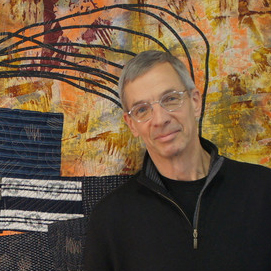Having long been a champion of the validity and worth of individual expression, I found it a rare and difficult challenge to select just 30 works for this exhibition. I am not sure why I found the difficulty surprising, since it was exactly the job for which I had signed up, but I guess I did not expect to find such a foggy or non-existent border between those I wanted to keep in and those I would be forced to leave out. I wanted to put together a coherent exhibition that would convey a sense of my own aesthetic taste and values. By sorting the entries into categories, I ended up seeing two basic approaches—the pictorial and the abstract.
To me, music is fundamentally abstract. It does not tell me what to think, it only relates a piece of the universe to which the composer has access and the ability to convey. My relationship to music is physical and emotional rather than literal and orderly. So I decided to stick with abstract modes of expression rather than pictorial. While I did keep a few representational images, I chose quilts where the artist employed more abstract devices rather than realistic ones. They reflect my own experience of music.
Music has informed much of my own quiltmaking. The first genre I studied seriously was country blues: the acoustic music of Lightning Hopkins, Mance Lipscomb, Mississippi John Hurt, and others from Mississippi and Texas. Their rough, scrappy, often improvisational music had a counterpart in the rough, scrappy, often improvisational quilts to which I was attracted. My preference for quilts that make bold, dynamic statements over quilts of elaborate symmetry has a counterpart in my preference for music that makes a bold statement, with strong dynamic expression.
I imagine this is a common cultural thread—that we can all find similarities between our taste in one art form and our taste in another. If all forms of art share certain qualities of tension and release, of harmonic and enharmonic elements, then it would follow that we would prefer and enjoy similar sets of these elements across the spectrum of art forms. What I particularly enjoy is seeing the variety of preferences that people have, and the ways those preferences are expressed in each person’s creative output. In fact, that is what I seek above all else.
For many years I’ve studied old quilts and thought about how they came to be so varied—how there could have been hundreds of thousands of quilts made in the 19th century with no two being exactly alike. I feel that the single greatest achievement of the 19th century quilters was the invention of a format that allowed infinite creativity. Being extra-academic, quilters were free from institutional ways of seeing and making, which then allowed them to sew anything together in any way they could conceive. This freedom of individual expression is what led to so many masterpiece creations of the 19th and early 20th centuries, and it has stayed with us in all our quilt artistry. So I see these contemporary art quilts as a result of that aspect of the tradition, rather than a break from it. As we all make our own “music,” and make our own voices heard through our quilt art, we continue that theme of creative freedom.
SAQA has the ability to promote such individual expression among quilt artists. Through exhibitions like these we can foster individual ways of making, thinking, and seeing the world. I am grateful that such an organization exists for quiltmakers who want to make art. I am also proud of all the artists who entered this exhibition and hope that this particular selection of works finds a welcome place in the world.
— Joe Cunningham
 Joe Cunningham began making quilts professionally in 1979. His early mentors were steeped in quilt history and traditions, leading Cunningham to a life study of quilt history and a love of traditional technique. Over the years his quilts evolved into his own unique, personal style. His quilts are in the permanent collections of museum, and numerous private collections. Cunningham’s books on quilts include his 2010 book “Men and the Art of Quiltmaking”, the Shelburne Museum’s exhibition catalogue, “Man-Made Quilts: Civil War to the Present,” and his essay for the de Young Museum show “Amish Abstractions: Quilts from the Collection of Faith and Stephen Brown.”
Joe Cunningham began making quilts professionally in 1979. His early mentors were steeped in quilt history and traditions, leading Cunningham to a life study of quilt history and a love of traditional technique. Over the years his quilts evolved into his own unique, personal style. His quilts are in the permanent collections of museum, and numerous private collections. Cunningham’s books on quilts include his 2010 book “Men and the Art of Quiltmaking”, the Shelburne Museum’s exhibition catalogue, “Man-Made Quilts: Civil War to the Present,” and his essay for the de Young Museum show “Amish Abstractions: Quilts from the Collection of Faith and Stephen Brown.”
